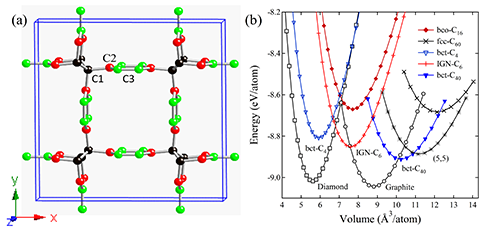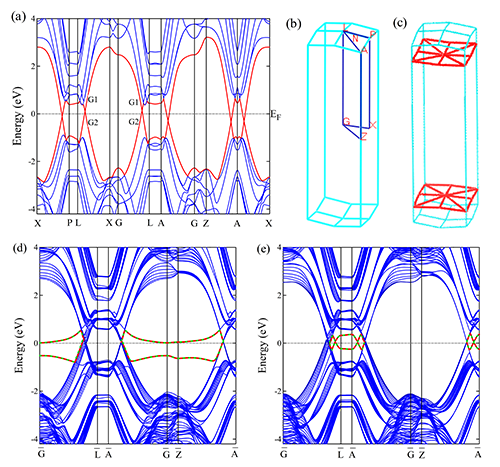Graphene Network Structure of BCT-C<sub>40</sub>: A New Topological Nodal-Net Semimetal
Date:18-01-2018 Print
The valence electrons of a carbon atom can form sp3-, sp2-, and sp-hybridized states that support single, double, triple, and aromatic carbon-carbon bonds, which profoundly impact a wide range of properties of carbon-based materials. At ambient conditions, graphite is the most stable carbon phase; its honeycomb lattice can be viewed as a planar molecule comprising benzene rings in an all-sp2 bonding state, which hosts a semimetallic electronic structure. Diamond, which is related to polycyclic saturated hydrocarbon, is the second most stable allotrope of carbon with all the carbon atoms in a methane-like tetrahedral sp3 bonding, forming a very rigid three-dimensional carbon network with a larger band gap of 5.47 eV. Meanwhile, the simplest carbon linear chain has a polyyne-like alternating single and triple carbon-carbon bonds, showing as a semiconductor with a band gap of 2.56 eV. In addition, graphitic sheet can be peeled off or wrapped into new structural forms such as fullerenes, nanotubes, and graphene.
Recently several theoretical studies have predicted a number of carbon network topological nodal line semimetals in all-sp2 or sp2-sp3 hybrid networks. Hongming Weng et al. reported an all-sp2 Mackay-Terrones carbon crystal with topological node lines in bulk [PRB 92, 045108 (2015)]. Jian-Tao Wang et al. reported a body-centered orthorhombic C16 (bco-C16) carbon phase in all-sp2 bonding networks with a continuous nodal ring [PRL 116, 195501 (2016)], an A-type nodal line, inside a mirror plane in the Brillouin zone (BZ). Also, an interpenetrated graphene network (IGN-C6) in sp2-sp3 bonding has been proposed with a B-type nodal line, which go through the whole BZ [Nano Lett. 15, 6974 (2015)]. These node lines are protected by the coexistence of the time-reversal and inversion symmetry, and when the node lines are projected onto certain surfaces to form a “drumhead”-like surface flat bands either inside or outside of the nodal line.
Based on above concept, recently, Prof. WANG Jiantao, WENG Hongming, and Dr. NIE Simin in IOP-CAS in collaboration with Prof. KAWAZOE Yoshiyuki from Tohoku University, Japan and Prof. CHEN Changfeng from University of Nevada, Las Vegas, USA, reported a new body-centered tetragonal carbon allotrope in I4/mmm (No.139) symmetry. This new carbon phase has a 40-atom unit cell, thus termed bct-C40. It can be regarded as a structural modification of the (5,5) carbon nanotube (CNT) in sp2-sp3 hybrid bonding, consisting of benzene linear chains (C2 and C3 in Fig. 1a) connected by alkane-like single carbon-carbon bond (C1 in Fig. 1a). Total-energy calculations show that bct-C40 is more favorable the solid fcc-C60, bco-C16, IGN-C6, and BCT-C4 in energy (see Fig. 1b), and its dynamic stability is verified by phonon simulations. Electronic band structure calculations show that bct-C40 belongs to a new class of topological nodal-net semimetals. The valence and conduction bands exhibit linear dispersion near the Fermi energy and cross at the Fermi level (see Fig. 2a), and further analysis of the band structure in the full BZ indicates that the band crossing points (or nodal points) of the valence and conduction bands in bco-C40 form several B-type nodal lines constrained on the high symmetric mirror planes (see Fig. 2b,2c). These nodal lines are topologically robust protected by the coexisting time-reversal and inversion symmetries and all go through the whole BZ, leading to a two-dimensional net-like structure (see Fig. 2c). Moreover, when the nodal lines consisting of the nodal nets are projected onto the (100) surfaces, the projection regions are superposed and our calculations show two coupled surface flat bands with one occupied and the other unoccupied, either inside (see Fig. 2d) or outside (see Fig. 2e) of the nodal net, depending on the surfaces saturated without or with hydrogen atoms. This finding provides a multiband rather than a single-band based flat-band platform to study possible novel correlated effects, such as flat-band driven high-temperature superconductivity, chiral superconductivity, and more.
This study entitled “Topological Nodal-Net Semimetal in a Graphene Network Structure” was published on Physical Review Letters 120, 026402 (2018).
This study was supported by the National Natural Science Foundation of China (Grants No. 11674364 and No. 11674369) and the Strategic Priority Research Program of the Chinese Academy of Sciences (Grant No. XDB07000000). H. W. acknowledges the support from the National Key Research and Development Program of China (Grant No. 2016YFA0300600). C. F. C. acknowledges support by DOE under Cooperative Agreement No. DE-NA0001982.
 |
| Fig.1 Structure of bct-C40and the calculated total enengies. (a) The 40-atom unit cell of bct-C40with lattice parameters a = 12.901 Å, c = 2.460 Å, occupying the 8h(0.7257, 0.7257, 0.5)-C1, 16l (0.7370, 0.6096, 0.5)-C2, and 16l (0.7615, 0.0558, 0.5)-C3 Wyckoff positions. (b) Calculated energies vs volume per atom for bct-C40compared to graphite, fcc-C60, bco-C16, (5,5) CNT, bct-C4, diamond, and IGN-C6. (Image by Institute of Physics) |
 |
| Fig.2 Calculated bulk and surface band structures of bct-C40at equilibrium lattice parameters. (a) The bulk band structure along several high-symmetry directions. G1 and G2 indicate the irreducible representation of the two crossing bands, respectively. (b) The Brillouin zone with several high-symmetry momenta indicated. (c) The nodal net (red lines) formed by several nodal lines is in the high symmetric mirror plane. (d) and (e) show the (100) surface band states. In (e), the surface dangling bonds are saturated with hydrogen atoms. There are two coupled surface flat bands with one occupied and the other unoccupied around the Fermi level . (Image by Institute of Physics) |
Contact:
Institute of Physics
WANG Jiantao
Email:wjt@iphy.ac.cn
Key word:
Morphed graphene nanostructures; Hybrid sp2-sp3 bonding networks; Topological node-net semimetal.
Abstract:
Topological semimetals are characterized by the nodal points in their electronic structure near the Fermi level, either discrete or forming a continuous line or ring, which are responsible for exotic properties related to the topology of bulk bands. Here we identify by ab initio calculations a distinct topological semimetal that exhibits nodal nets comprising multiple interconnected nodal lines in bulk and have two coupled drumheadlike flat bands around the Fermi level on its surface. This nodal net semimetal state is proposed to be realized in a graphene network structure that can be constructed by inserting a benzene ring into each carbon-carbon bond in the bct-C4 lattice or by a crystalline modification of the (5,5) carbon nanotube. These results expand the realm of nodal manifolds in topological semimetals, offering a new platform for exploring novel physics in these fascinating materials.

